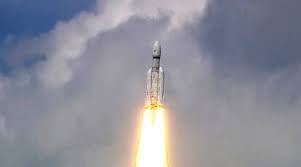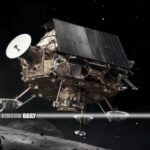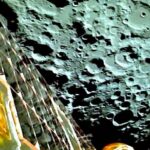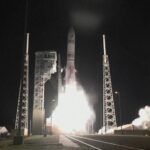
India has embarked upon its third Moon mission, with the successful launching of the Chandrayaan-3 spacecraft, aiming to be only the fourth country to achieve a soft landing on the lunar surface, after its predecessor: Chandrayaan-2, failed in the final seconds of its attempt, back in 2019.
At mission control of the Satish Dhawan space centre, on the barrier island of Sriharikota, off the Bay of Bengal, in the Indian region of Andhra Pradesh, scientists confirmed the take-off had been a success and burst into spontaneous applause as the rocket lifted off at 14:35 IST (09:05GMT/10:05 BST).
It will take somewhere between 15 to 20 days to enter the Moon’s orbit with officials expecting the lander to reach the Moon itself on 23/24 August. The hope and plan is to become the first to land near its south pole, which has rarely been explored in the past.
Chandrayaan-1 makes key discoveries
It was back in 2008 when Chandrayaan-1 became the country’s very first Moon mission, and although no attempt was made to land safely, it did deliberately release an “impactor” and the debris from that was analysed by the orbiting spacecraft.
It also carried out out a detailed search for water on the surface and made key discoveries including the establishing of the fact that the Moon has an atmosphere during daytime.
Chandrayaan-2 last minute failure
Then in July 2019 Chandrayaan-2 was launched, and in actual fact its orbiter continues circle and study to this day. Also sent up was a lander and a rover, but unfortunately due to a last-minute glitch in the breaking system, it failed to make a soft landing and crashed during touchdown.
Same goals after lessons learned
Chandrayaan-3, which weighs 3,900kg and cost 6.1bn rupees ($75m; £58m) has been sent up to make a second attempt, with scientists believing they have learned lessons from the previous attempt and any errors made then have been successfully corrected.
The lander (called Vikram, after the founder of Isro) weighs about 1,500kg and carries within its belly the 26kg six-wheeled rover which is named Pragyaan, which is the Sanskrit word for wisdom. This will eject and roam around the rocks and craters on Moon’s surface, gathering crucial data and images to be sent back to Earth for analysis.
Focus is on the south pole
Sreedhara Somanath, the secretary of India’s space department explained further: “The rover is carrying five instruments which will focus on finding out about the physical characteristics of the surface of the Moon, the atmosphere close to the surface and the tectonic activity to study what goes on below the surface.”
He said it was hoped that an exciting new discovery will be made at the Moon’s south pole, but added with a degree of caution, that the intended area for landing did carry with it higher risks.
It is an area that remains in shadow and is much larger than that of Moon’s north pole and scientists believe that presents a much greater possibility of finding water in that region.
Pride for the leaders
Home Minister Amit Shah spoke of the tireless pursuit by the scientists which he said had propelled India on the path of “scripting a remarkable space odyssey for generations to cherish”.
Prime Minister Narendra Modi also praised the scientists “relentless dedication” in a tweeted message to the nation, going on to call the launch a “momentous achievement” and he saluted their “spirit and ingenuity.” He added: “Chandrayaan-3 scripts a new chapter in India’s space odyssey as it soars high, elevating the dreams and ambitions of every Indian.”
Aiming to be only the fourth soft landers
The Moon has often been described as a gateway to deep space and renewed interest is gaining pace in many of the powerful nations of the world. If this latest mission achieves all of its goals then India will become only the fourth country after the US, China and the former Soviet Union, to successfully undertake a soft landing on the Moon.






0 Comments